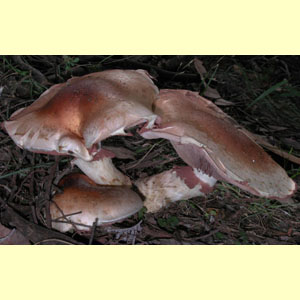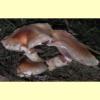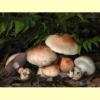
images/Hebeloma_victoriense/Hebeloma_victoriense_KRT2695.jpg
Medium to very large agaric, growing on the ground with deep reddish brown spore print (see below). Pileus pale or brown, viscid or not. Lamellae sinuate or notched. Stipe central. Partial veil remnants a membranous annulus. Spores yellow-brown, warty; germ pore absent. Cheilocystidia present. Lamellar trama regular. Pileipellis a cutis. Clamp connections present.
The spore print is an unusual deep reddish or purplish brown colour, as can be seen from spores deposited on the upper surface of the annulus. Spore print colour was described by Holland & Pegler (1983) as vinaceous brown, fading to fawn on drying. The colours given for the fresh spore print (RIDGEWAY Russet-Vinaceous, MUNSELL 9R 5.3/4.7, METHUEN about 7-8C5) are redder than clay-brown and not as orange as rusty brown (as the two categories are used in FunKey). Furthermore, the colour when dry is described as 'clay' but from the colours cited (RIDGEWAY Army Brown, MUNSELL 2.5YR 4.5/3. METHUEN around 6E4, 7E4-5) is in fact quite a dark brown. Therefore, the species is keyed out as having both clay, rusty and dark brown spore print colour (but not purple-brown, which in FunKey refers to a much darker colour).
Cortinarius australiensis shares the robust fruit-bodies and membranous annulus of
Hebeloma victoriense, but the spore print is rusty brown and cheilocystidia are absent. Members of
Cortinarius morphogroup Rozites also have a membranous annulus, but the pileus is usually quite glutinous and cheilocystidia are absent. Some
Gymnopilus species, such as
G. junonius, are large and annulate, but the spore print is rusty brown, and they usually grow on wood or litter and often have capitate cheilocystidia. The lamellae can be pinkish in immature
Agaricus, but they are free, and the spores are smooth.
One species:
Hebeloma victoriense is keyed out separately from other species of
Hebeloma because of the distinctive combination of a well-developed annulus and reddish brown spore print.
Hebeloma victoriense Holland & Pegler,
Trans. Brit. Mycol. Soc. 80: 157 (1983).
N.S.W., Vic. and Tas. (and possibly also S.A.).
In native forests.
On the ground.
Ectomycorrhizal
Fuhrer, B. (2005),
A Field Guide to Australian Fungi. Bloomings Books, Hawthorn. [
Description and
Illustration of
H. victoriense]
Holland, A.A. & Pegler, D.N. (1983), Hebeloma victoriense and the genus Metraria, Trans. Brit. Mycol. Soc. 80: 157–186. [Description, B&W Illustration and Microcharacters of H. victoriense]



_AJ_19_sml.jpg)
